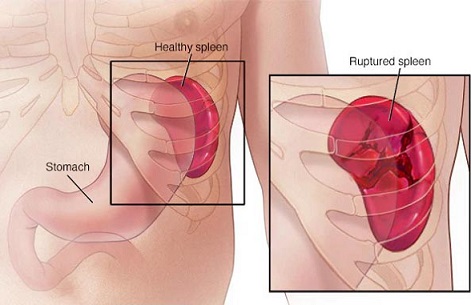Nikhil Prasad Fact checked by:Thailand Medical News Team Jul 18, 2024 1 year, 5 months, 2 weeks, 3 days, 23 hours, 49 minutes ago
Medical News: In a rare and alarming medical case, a 16-year-old boy experienced a spontaneous splenic rupture (SSR) as a complication of infectious mononucleosis (IM), more commonly known as mono or the “kissing disease.” This
Medical News report delves into the details of this unusual occurrence, emphasizing the importance of awareness and prompt treatment.
 Doctors warn that kissing disease can cause potentially fatal spleen rupture
Doctors warn that kissing disease can cause potentially fatal spleen rupture
The Case: A Teenager’s Health Crisis
The young patient, whose case was treated at the General Hospital of Katerini, Greece, presented to the emergency department with acute pain in the upper left quadrant of his abdomen. Just three weeks prior, he had been diagnosed with infectious mononucleosis (IM), confirmed by a positive monotest. Initially, he exhibited symptoms typical of IM: a sore throat, mild fever, and swollen lymph nodes. His initial lab results showed elevated white blood cells and liver enzymes, but no splenic enlargement was detected at that time.
Unexpected Turn: The Emergency Visit
Upon returning to the hospital, the boy’s condition had escalated. He was experiencing significant abdominal pain and was mildly tachycardic. This article underscores the importance of vigilance in such cases. Initial lab tests revealed a slight drop in hemoglobin and a slight increase in white blood cell count, raising concerns.
Diagnostic Imaging: Revealing the Hidden Danger
An urgent abdominal ultrasound revealed an enlarged spleen (21 cm in diameter) with a large subcapsular hematoma (13 cm in diameter) and a significant amount of complex fluid within the abdominal cavity. To confirm these findings, an abdominal CT scan was performed, which corroborated the ultrasound results, showing a maximum spleen diameter of 21.60 cm and the presence of the hematoma.
Emergency Surgery: A Life-Saving Procedure
Given the severity of the findings and the drop in hemoglobin levels, the medical team decided to perform an emergency exploratory laparotomy. During the surgery, a large amount of hemoperitoneum (blood in the abdominal cavity) was evacuated, and an emergent splenectomy was carried out to remove the ruptured spleen.
The patient’s post-operative recovery was closely monitored, and fortunately, he experienced no complications. Before being discharged, he received vaccinations against Pneumococcal, Meningococcal, and Hemophilus influenzae (Hib) and was prescribed antibiotics to prevent infections typically associated with splenectomy.
Understanding Spontaneous Splenic Rupture
SSR is an extremely rare but serious complication of infectious mononucleosis (IM), occurring in only 0.1-0.5% of patients with confirmed IM. The Epstein-Barr virus (EBV), which causes IM, leads to the accumulation of mononuclear cells in the lymphoid tissues, resulting in the enlargement of the spleen. As the spleen enlarges, its capsule thins, making it v
ulnerable to rupture.
Managing Splenic Injuries: A Medical Debate
The management of splenic injuries varies depending on several factors, including the patient’s hemodynamic status and the availability of medical resources. In stable patients, splenic preservation is preferred to avoid the risks associated with splenectomy, such as increased susceptibility to infections. Techniques like splenic artery embolization can sometimes be used to preserve the spleen.
However, in this case, due to the severity of the hemorrhage and the patient’s condition, splenectomy was the necessary course of action. The surgery involved removing the damaged spleen, a procedure that requires careful post-operative management to prevent infections and other complications.
Raising Awareness: Preventing Splenic Rupture in IM Patients
This case highlights the importance of raising awareness among healthcare providers and patients about the risks associated with infectious mononucleosis (IM). Although IM is generally a self-limiting illness, it can have severe complications, as demonstrated in this case.
Healthcare guidelines recommend that patients with infectious mononucleosis (IM), avoid contact sports and heavy lifting for at least a month to reduce the risk of splenic rupture. However, there is no international consensus on the exact duration for avoiding strenuous activities. It is advised that patients remain cautious for up to eight weeks following infection.
Conclusion: A Rare Complication with Critical Implications
This case serves as a stark reminder of the potential severity of complications associated with infectious mononucleosis (IM). The study, conducted by researchers from the General Hospital of Katerini, emphasizes the need for vigilance in diagnosing and treating IM patients, especially when presenting with abdominal pain.
The study findings were published in the peer-reviewed journal: Diagnostics.
https://www.mdpi.com/2075-4418/14/14/1536
For the latest on infectious mononucleosis (IM), keep on logging to Thailand
Medical News.
Read Also:
https://www.thailandmedical.news/news/increased-unsafe-humping-is-causing-sexually-transmitted-diseases-to-rise-at-exponential-rates-globally
https://www.thailandmedical.news/news/std-news-tripling-of-drug-resistant-gonorrhea-cases-in-china-is-a-global-threat
